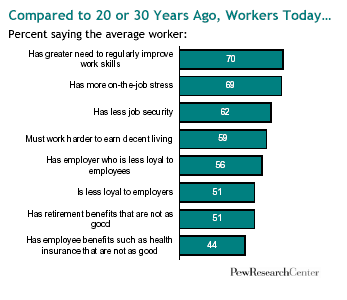 Americans believe that workers in this country are worse off now than a generation ago – toiling longer and harder for less in wages and benefits, for employers who aren’t as loyal as they once were, in jobs that aren’t as secure, and in a global economy that might very well send their work overseas.
Americans believe that workers in this country are worse off now than a generation ago – toiling longer and harder for less in wages and benefits, for employers who aren’t as loyal as they once were, in jobs that aren’t as secure, and in a global economy that might very well send their work overseas.
Yet the public has generally taken in stride this perceived fraying of the social safety net at work, according to a new Pew Research Center nationwide survey. Most people still have positive feelings about their own jobs, and even though many are troubled by the way the forces of modernization and globalization are affecting the American workplace, the level of public concern today is not substantially greater than it had been a decade or two ago.
To be sure, most Americans are well aware that the social contract associated with work in America is going through a period of profound change – with the industrial-era model of secure jobs with good wages and benefits that predominated until roughly a generation ago giving way to a more cost-conscious and globally-competitive workplace marked by stagnant real wages, cutbacks to health benefits and retirement plans, and growing threats of having jobs outsourced abroad.
When asked whether each of eight different aspects of work life have gotten better, worse or remained the same for the typical American worker over the past 20 or 30 years, a majority or plurality of respondents in the Pew survey answered worse to all eight questions.
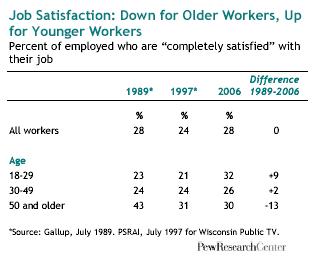 The telephone survey was conducted from June 20 through July 16, 2006 among a nationally representative sample of 2,003 Americans. The margin of error is plus or minus 2.5 percentage points.
The telephone survey was conducted from June 20 through July 16, 2006 among a nationally representative sample of 2,003 Americans. The margin of error is plus or minus 2.5 percentage points.
These downbeat assessments do not extend to ratings of one’s own job, however. Nearly nine-in-ten employed adults in this survey say they are either completely (28%) or mostly (61%) satisfied with their own jobs, a level of satisfaction on par with findings from similar national surveys taken in 1989 and 19971.
But there’s been a notable change over time in the age composition of satisfied workers. Surveys taken in 1989 and 1997 found that many more older workers (ages 50-plus) than younger workers (ages 18-29) reported being very satisfied with their job.
In the latest Pew survey, the two age groups report about the same level of satisfaction with their jobs. That’s because since 1989, the number of workers ages 50 and older who report feeling completely satisfied with their job has fallen (to 30% now, from 43% in a 1989 Gallup Poll) while the number of 18-29 year olds who report feeling completely satisfied has risen (to 32% now, from 23% in 1989).
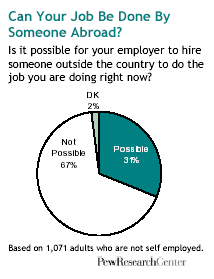 There is one key job-security concern that affects workers of all ages: nearly a third of them (31%) say they believe it would be possible for their employer to hire someone outside the country to do the job they are doing right now.
There is one key job-security concern that affects workers of all ages: nearly a third of them (31%) say they believe it would be possible for their employer to hire someone outside the country to do the job they are doing right now.
However, this assessment that offshoring is a potential threat to one’s own job has not been accompanied by a spike in the percentage of workers who believe they are in danger of being laid off in the coming year. Just 13% of workers surveyed say it is “very” or “fairly” likely that this will happen to them, a figure that is virtually unchanged since 1975, when Gallup began asking this question.
Growing Discontent over Benefits
Even though most workers are generally satisfied with their jobs, the Pew survey finds that there are pockets of discontent with various aspects of work life. About a quarter of all workers are unhappy with the retirement plan offered by their employer (28% completely or mostly dissatisfied), the health insurance benefits (27%), the level of on-the-job stress (27%), the amount of money they earn (24%), and their chances of promotion (23%).
In a similar vein, when Americans are asked not about their own jobs but about the jobs of the average working person, employee benefits, such as health insurance and paid vacations, are the area where negative assessments have grown most sharply over time.
As recently as 1997, a plurality of employed adults (41%) said in a survey by Princeton Survey Research Associates International that employee benefits were better than they had been 20 or 30 years earlier. In the latest Pew survey, a near majority of workers (45%) now says benefits are worse than they had been 20 or 30 years ago, while the rest say they are either better (26%) or about the same (26%).
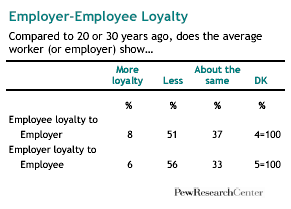 This downbeat rating of employee benefits is hardly surprising given cutbacks that have affected millions of workers, retirees and their families in recent years. And these cutbacks, in turn, may also explain another sharply negative finding in the survey: by a margin of 56% to 6%, Americans say employers are less, rather than more, loyal to workers now than they were a generation ago (another third say employers show the same loyalty now as they did then).
This downbeat rating of employee benefits is hardly surprising given cutbacks that have affected millions of workers, retirees and their families in recent years. And these cutbacks, in turn, may also explain another sharply negative finding in the survey: by a margin of 56% to 6%, Americans say employers are less, rather than more, loyal to workers now than they were a generation ago (another third say employers show the same loyalty now as they did then).
But loyalty – or the lack of it – is a two-way street. By a similar margin of 51% to 8%, the public says workers show less, rather than more loyalty, to their employers now than they did a generation ago, with 37% saying the level of employee loyalty is about the same now as then.
Weighing the Forces of Change
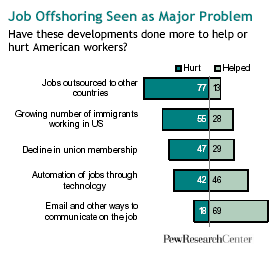 The Pew survey asked respondents whether five broad trends affecting the modern workplace – immigration, offshoring, automation, modern communication technology and declining unionization – have helped or hurt American workers.
The Pew survey asked respondents whether five broad trends affecting the modern workplace – immigration, offshoring, automation, modern communication technology and declining unionization – have helped or hurt American workers.
The offshoring of jobs drew the most negative assessments, with the public saying by a margin of more than 5-1 that this has hurt rather than helped American workers. The public says the same thing about the increasing number of immigrants working in America, but they do so by a more modest margin of 2-1. They also say the decline in union membership has hurt rather than helped, but the margin on this question is more narrow, 3-2.
The public renders a split verdict on the automation of jobs, with people slightly more likely to say it has helped (46%) than hurt (42%). Meantime, Americans are overwhelmingly positive about one particular new form of technology in the workplace — more than two-thirds (69%) say that the use of email and other new ways to communicate on the job has been helpful.
Read the full report for more details.


